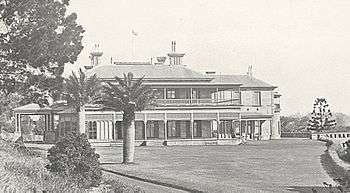Robert Towns
.jpg)
Robert Towns (c. 1794 – 11 April 1873) was a businessman, pastoralist, and founder of Townsville, Queensland. Much of his success came from blackbirding, the practise of coercing and kidnapping South Sea Islanders as slave labourers.[1]
Early life
Towns was born at Longhorsley, Northumberland, England, on 10 November 1794. This is the date usually given, and it agrees with his death notice which stated that he was then in his seventy-ninth year.[2] The date given by the Australian Encyclopaedia, 1791, appears to be more likely, as after being educated at a village school Towns went to sea, was a mate in 1811, and a master in the following year. In 1813 he was captain of a brig in the Mediterranean, and in 1827 he made his first voyage to Australia as captain of The Brothers.
New South Wales

On 28 December 1833 he married Sophia Wentworth at St Philip's Church, Sydney; the couple honeymooned at Toongabbie at the estate of William Charles Wentworth (Sophia's brother).[3][4]
In 1842 he established a mercantile and shipping business (Robert Towns & Co., General Merchants, Ship and Commission Agents) at Sydney. In a letter to William de Salis dated Sydney, 4 January 1853 Towns describes a shipping issue:
- 'I am afraid our Coolie trade is over, the rascals have been so troublesome, nobody likes to employ them, and our laws are so defective & punishment so trifling for such offences that they laugh at the idea of being put in jail – It is possible she may get a Charter elsewhere with Coolies...'
Towns was a member of the initial New South Wales Legislative Council from 22 May 1856 to 10 May 1861 (a 5-year appointment, terminated by his resignation in support of the council president) and then re-appointed for life on 23 June 1863, terminating at his death on 11 April 1873.[5] Although he did not take a leading part in politics, his advice was much sought in matters affecting business.[6]
He lived from 1864 to 1873 in Cranbrook House on New South Head Road in Rose Bay, Sydney.[7]
Queensland enterprises
He afterwards bought station properties in Queensland, and about 1860 or a little later began growing cotton, relying on South Sea Islander slaves to do the cultivation and picking. Many attempts had been made to grow cotton in Australia before this time, but Towns was the first to do so on a large scale. Realizing that a port was needed on the Queensland coast north of Bowen, Towns arranged for explorations to be made from his stations, a suitable site was found at Cleveland Bay, and on to October 1865 it was gazetted as a port of entry and named Townsville.
Local legend (as yet unsubstantiated) suggests that Towns was involved in a coffee planting venture. The story goes that Towns was privy to a plan by the government to grant title to land under cultivation. He procured a boat load of coffee beans, arranged for them to be planted on a substantial tract of land in the Townsville area and applied for the title to the land. The coffee crop failed because the beans had been roasted before Towns acquired them. However, this detail did not prevent Towns from succeeding in his efforts to acquire the land.
Later life
In 1870, Robert Towns was attacked by paralysis and his health was precarious thereafter. He suffered a further stroke on 7 April 1873 and died at his home, Cranbrook, on 11 April 1873.[2][6] He was buried on 15 April 1873 in the Balmain Cemetery.[8][9] The Balmain Cemetery closed in 1912 and, in 1941, it was decided to convert it into parkland (the Pioneer's Memorial Park) and advertisements were placed for families to make arrangements for re-interment of bodies or removal of memorials. As a result, the memorial stone from Robert Town's grave was relocated to stand atop a monument at Castle Hill, Townsville.[10]
After a number of subsequent owners, his home Cranbrook House would become Cranbrook School.
On Sunday 1 November 1964, the Townsville Centenary Monument was unveiled on The Strand commemorating 100 years of European settlement in Townsville, with particular mention made of four men: Robert Towns, Andrew Ball, Mark Watt Reid and John Melton Black.[11]


References
- ↑ "'Blackbirding' shame yet to be acknowledged in Australia". The Sydney Morning Herald. Sydney. 3 June 2013. Retrieved 16 October 2016.
- 1 2 "Family Notices.". The Sydney Morning Herald. National Library of Australia. 12 April 1873. p. 1. Retrieved 21 December 2013.
- ↑ "Marriage Records Search". New South Wales Government. Retrieved 21 December 2013.
- ↑ "Family Notices.". The Australian. Sydney: National Library of Australia. 3 January 1834. p. 2. Retrieved 21 December 2013.
- ↑ "Mr Robert Towns (1794–1873)". Former Members. New South Wales Parliament. Retrieved 21 December 2013.
- 1 2 "The Hon. Robert Towns.". Australian Town and Country Journal (Sydney, NSW : 1870 - 1907). Sydney, NSW: National Library of Australia. 19 April 1873. p. 9. Retrieved 21 January 2016.
- ↑ Shineberg, D. "Towns, Robert (1794–1873)". Australian Dictionary of Biography. Retrieved 21 December 2013.
- ↑ "Family Notices.". The Sydney Morning Herald. National Library of Australia. 12 April 1873. p. 12. Retrieved 21 December 2013.
- ↑ "Balmain Cemetery Registry Index: 1868-1912" (PDF). Retrieved 21 December 2013.
- ↑ "Balmain Cemetery". Leichhardt City Council. Retrieved 21 December 2013.
- ↑ "Townsville Centenary Monument | Monument Australia". monumentaustralia.org.au. Retrieved 2016-01-17.
External links
- Serle, Percival (1949). "Towns, Robert". Dictionary of Australian Biography. Sydney: Angus and Robertson.